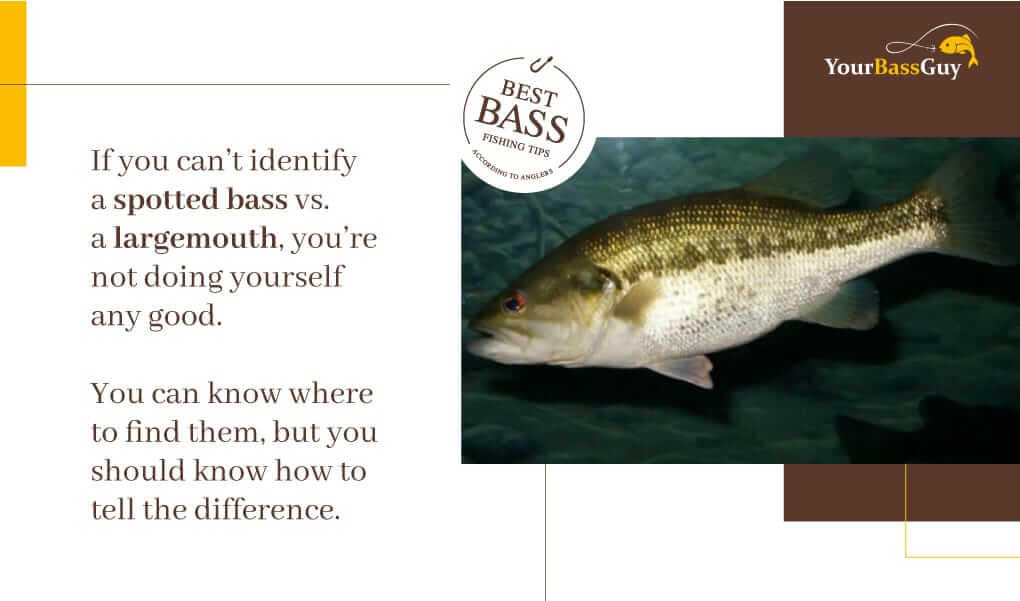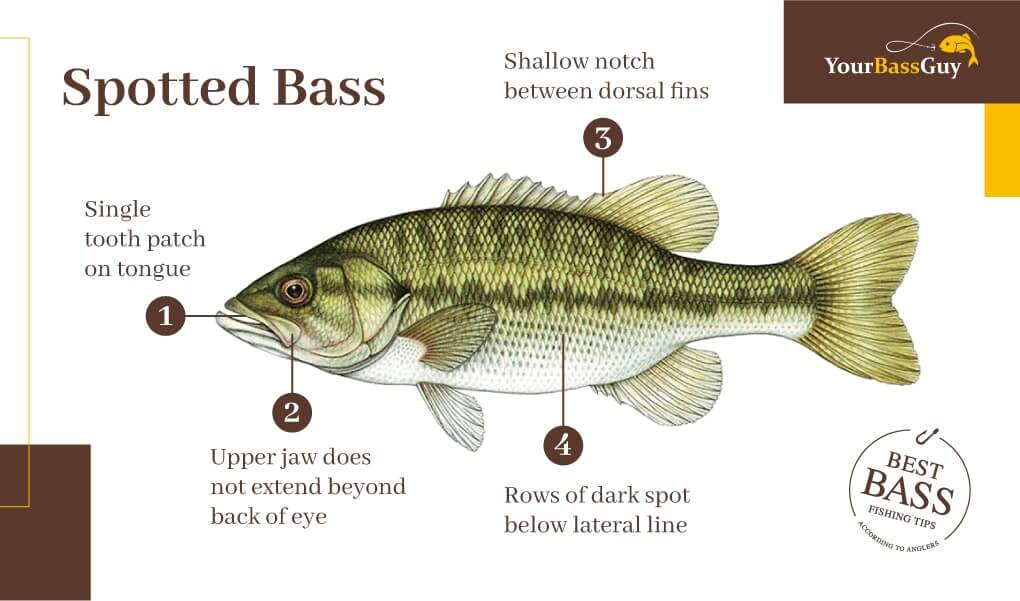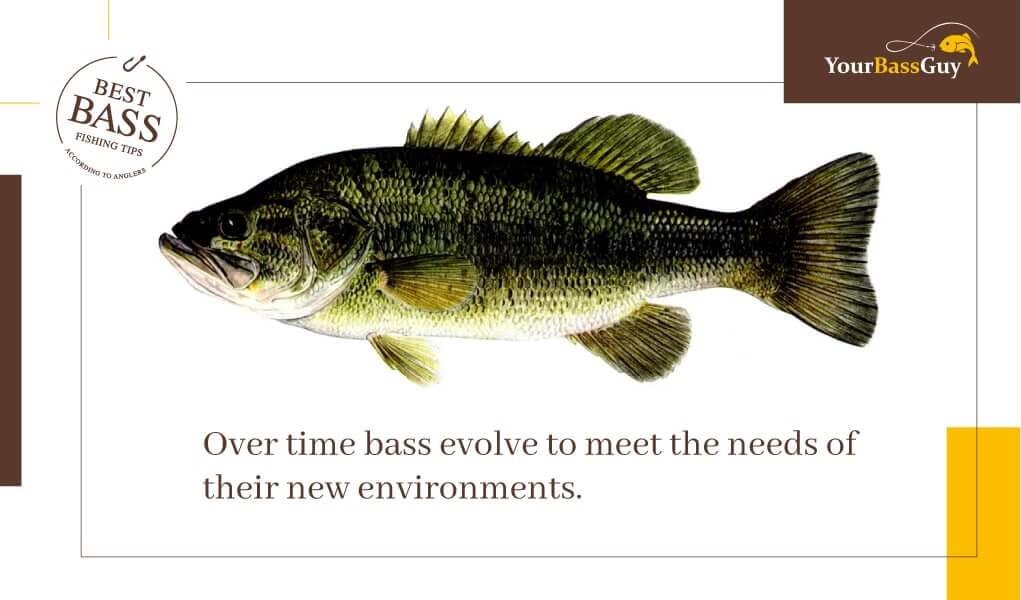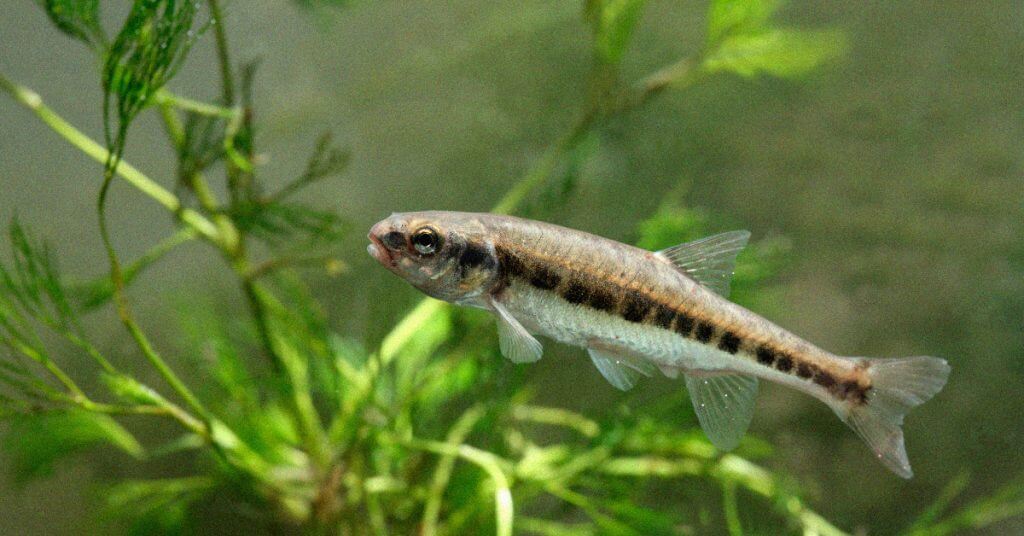Understanding spotted bass vs largemouth is not always easy unless you know what features and characteristics to look for.
Looking at largemouth bass pics, we can see that they have much larger jaws and a big white belly that stands out.
Spotted bass pictures show us a much darker set of scales with spots that extend down onto their belly.
After almost two decades on the water and plenty of online research, I’ve compiled everything you could need to know to tell these two bass apart.
By the end of this article, you’ll have all you need as well.
Difference Between Largemouth and Spotted Bass
The first thing I want to talk about is what is likely on everyone’s mind.
What’s the difference in fishing for both of these species?
While the fishing might be primarily the same, how you locate them, and where you find them is a bit different.
You’ll usually find spotted (Kentucky) bass in clear water that is more open without a lot of vegetation.
Largemouth bass are found in both but most commonly in murkier waters.
Spotted bass also remain active all year, but largemouth slow down during the winter months.
Their metabolism slows much more, which makes it harder to catch them when the temperature drops.
Appearance

If you can’t identify a spotted bass vs. a largemouth, you’re not doing yourself any good. You can know where to find them, but you should know how to tell the difference. We’re going to break down each detail so you’ll know how to tell them apart.
Jaw Length
The first thing you should notice about these two bass are their jaws. Largemouth bass are known for their big jaw that extends past its eye on the top and sticks out further on the bottom. A spotted bass has a smaller upper jaw that doesn’t extend past the eye. Spotted bass have a mouth where both jaws are almost equal on top and bottom.
Dorsal Fin
Another key indicator of the type of bass you have is the dorsal fin. The dorsal fin is on top of the fish, and a spotted bass has a two-piece fin. It has a front and a back portion that come all the way down to the top of the fish.
A largemouth bass’s dorsal fin is altogether in one piece and doesn’t retreat down to the top of the fish.
Tongue
If you’re holding a bass in your hand and you’re not sure which kind you have, you can also open their mouth and take a look at the tongue. A spotted tongue will have a coarse patch right in the middle of the tongue. Largemouth bass have a smooth tongue, and while this is a minor difference, it is something you can notice right away if you look.
Cheek Scales
One of the best ways to tell the difference between largemouth and spotted bass is by looking at their scales. Spotted bass have small cheek scales that differ in size compared to the rest of their body.
Largemouth bass have scales that are the same size throughout their entire body. You’ll notice that their cheek scales are exactly the same as the rest.
Stomach Markers
In my opinion, this is the number one indicator of what kind of bass I have. You want to look at their stomach. On a largemouth bass, you’ll notice that they usually have a puffy white belly with very little coloring. Spotted bass will have lateral dark spots and lines throughout their whole body that extends down onto their belly. This change leaves little white area on the belly, and these spots are usually pretty dark.
Habitat

Spotted bass identification is great, but it doesn’t do you any good if you can’t catch any. In this section, we’ll cover some of the details about their habitats and how you can find them.
Spotted Bass
One huge misconception that many people have about spotted bass is that you can find them anywhere. This is completely false. It’s not often that you find spotted bass in natural waters. They’re most commonly located in reservoirs and slow-moving freshwater streams, but you won’t find them in natural lakes or ponds.
You don’t see them in these waters because it’s usually too murky for them. Spotted bass prefer clear water that doesn’t have a lot of mud or vegetation. Right off the bat, you should see this as a huge difference from largemouth bass who prefer murky water.
In terms of overall location, yes, you can find spotted bass anywhere in the country you would find largemouth.
Largemouth Bass
If you’ve fished largemouth bass before you know that you can pretty much find them anywhere. These fish are in abundance anywhere in the country, but there are a few key differences to understand.
1. Largemouth prefer murky water
2. They don’t like the cold
3. They’ll always hug vegetation and structure
4. You stand the best chance of finding them near the runoff
I don’t know if there’s any rhyme or reason behind some of these factors, it’s just behavioral. The only thing that matters is that you know and understand where to find them and how to identify them once you catch one.
The largemouth bass lifespan is around 16 years, and they mostly live a solitary life. Spotted bass live a much shorter life, usually no longer than 6 years.
Subspecies

Both these bass species are a type of black bass. They share a lot of coloration and lateral lines.
Over time bass evolve to meet the needs of their new environments. For example, bass that worked their way into Texas waters don’t live the same way as the ones in the Great Lakes; as a result, they must adapt to their surroundings.
For this reason, we have more subspecies of bass than we can name and many of which we probably don’t even know about.
Spotted Bass
Spotters have three primary subspecies that are worth mentioning:
- Northern Spotted Bass
- Alabama Spotted Bass
- Wichita Spotted Bass
The names of these give you a rough idea of where you’ll find them and why they might have adapted to new surroundings. The oldest type of spotted bass is the Northern, and as they worked their way down towards the South is when we started to see adaptations.
In general, you can find all three types of these fish throughout the country from Ohio down to the Gulf Coast.
Largemouth Bass
The largemouth subspecies are a bit easier to identify because there are only two of them. You’ve got the Northern Largemouth and the Florida Largemouth.
The Florida largemouth has smaller scales than your regular largemouth, and it grows much faster due to its habitation in warm waters and stocking efforts throughout the country.
Northern largemouth are likely what you’re used to seeing, and these are your standard largemouth bass that should fit the description of what we’ve been talking about so far throughout this article.
Behavior
Now let’s talk specifically about how they act in the water and when you get them on the hook. As soon as you hook a fish, you should have a general idea of what’s at the end just by how it handles the lure and drag on your reel.
Here are some behavioral characteristics that will help you learn how to catch more bass.
Spotted Bass
Whenever we interviewed the Spotted-Bass King, Cody Meyer, he was quick to point out how to catch them on spinning tackle.
“Spots like to suspend in open water. They roam,” Meyer said.
“They seldom go to the bottom. They don’t have a set home. You might catch them in one place one day and go back the next day and not catch a thing.”
But there were also advantages to that wanderlust behavior. The spots often school in that open water, meaning where you would find one, you would find plenty.
In general, largemouth bass are usually bigger as well. Spotters aren’t commonly larger than ten pounds, with that being one of the bigger sizes you’ll ever find.
Largemouth Bass
Many largemouth bass characteristics are hard to identify, but one thing that stands out is the fact that these bass rush to the top of the water when you get them on a hook. If the bass jumps out of the water with a hook, you know you’ve got a largemouth bass. Spotted bass will never do this since they retreat down.
Another significant factor is how they travel through the water. Largemouth bass are not afraid to travel alone while spotted bass school up almost always.
We’ve talked about it a little, but it’s worth mentioning again. Spotted bass will hang out around structure while largemouth tend to stick around vegetation, grass, and muck.
Best Season to Fish

While you can catch both of these species at any time of the year, you’ll want to keep your eyes peeled for certain scenarios that will yield the best results.
Spotted Bass
Spotted bass fishing is good all year long, but it’s extra eventful during the fall months. This time of year is when the fish hold out to their structure, stay in the same place for longer, and they will also dive a bit deeper so you’ll know where to find them.
At this time, I would suggest using a soft plastic with a drop shot or split shot if you’re really looking to bring ‘em home.
Keep in mind that this species also spends a lot of time around rocky areas and dams so you can look there as well.
Largemouth Bass
The best season for largemouth is any time when the water is warm. You can’t fish the fall or winter and expect to catch a lot of these guys because they slow down, they don’t bite as much, and it requires a change of strategy.
The best season I would say is late Spring, but it varies depending on your location. If you live in a place with four seasons, then late Spring is a great time to go out and catch a lot of largemouth bass. You’re waiting until after spawn when the bass are active again and ready to feed at full throttle.
Required Fishing Gear
I’m a big believer in my gear, and I think you can apply the same fishing gear to both of these types of bass. What’s most important is that you understand the differences in location and how you need to play your presentation based on where and when you’re fishing.
For both largemouth and spotted bass, I would use a spinning rod and reel with monofilament or braided line. If I’m using braided, I always use a fluorocarbon leader.
If we’re fishing soft plastics as I recommended above, I’ll go with mono and a leader using something like a Senko worm or some type of Berkley Powerbait.
All throughout the United States, bass anglers can expect to catch Largemouth but Kentucky bass tend to stay towards the middle of the country.
Whenever I’m fishing somewhere I’ve never been before, I always try to bring my depth finder along. If you’re traveling to new waters, you’ll want to grab an affordable fish finder that offers down and side imaging so you can get a good idea of what you’re dealing with.
Lastly, whenever I’m fishing for bass, I always bring along a few extra lures to help with certain scenarios. If you find that the water is heavily vegetated and there isn’t a lot of open area, you’ll want to target largemouth.
I like to cast right into the grass with a frog lure or a weedless rigged worm and present it nice and slowly. This strategy works great during hot summer mornings or even in late Spring if it’s nice and humid.
Final Thoughts
The largemouth vs. spotted bass debate is as old as anglers themselves. Knowing how to identify them is only a small portion of the battle, though. You need to know how to catch them, their fishing characteristics, and what types of lures to use. I hope this guide helps you catch more bass regardless of which species you find.





Very informative, thank you for this information. You have earned my trust.
Thanks so much for your comment! We appreciate it! :)
Thank you so much,for the enlightenment..
Thanks for the info…very helpful
Thanks Larry!